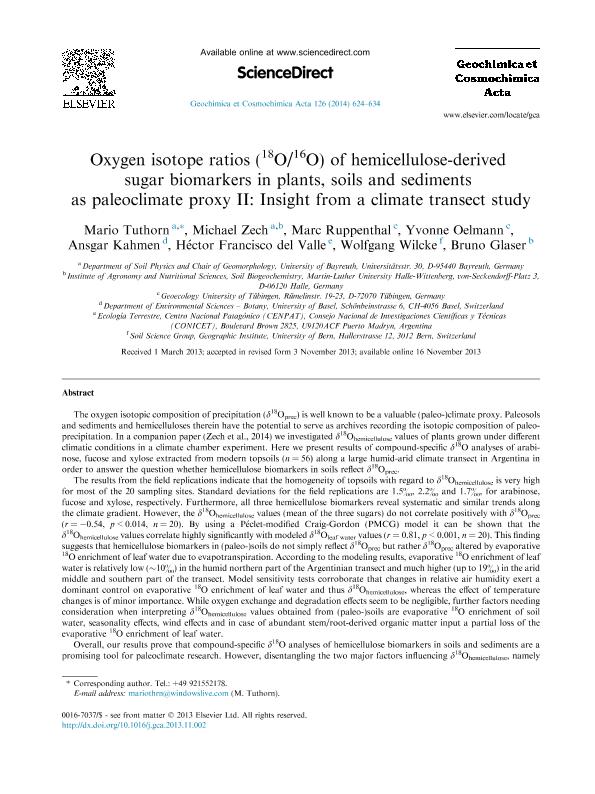Artículo
Oxygen isotope ratios ( 18O/ 16O) of hemicellulose-derived sugar biomarkers in plants, soils and sediments as paleoclimate proxy II: Insight from a climate transect study
Tuthorn, Mario; Zech, Michael; Ruppenthal, Marc; Oelmann, Yvonne; Kahmen, Ansgar; del Valle, Hector Francisco ; Wilcke, Wolfang; Glasser, Bruno
; Wilcke, Wolfang; Glasser, Bruno
 ; Wilcke, Wolfang; Glasser, Bruno
; Wilcke, Wolfang; Glasser, Bruno
Fecha de publicación:
11/2014
Editorial:
Elsevier
Revista:
Geochimica et Cosmochimica Acta
ISSN:
0016-7037
Idioma:
Inglés
Tipo de recurso:
Artículo publicado
Clasificación temática:
Resumen
The oxygen isotopic composition of precipitation (d18Oprec) is well known to be a valuable (paleo-)climate proxy. Paleosols and sediments and hemicelluloses therein have the potential to serve as archives recording the isotopic composition of paleo- precipitation. In a companion paper (Zech et al., 2014) we investigated d18Ohemicellulose values of plants grown under different climatic conditions in a climate chamber experiment. Here we present results of compound-specific d18O analyses of arabi- nose, fucose and xylose extracted from modern topsoils (n = 56) along a large humid-arid climate transect in Argentina in order to answer the question whether hemicellulose biomarkers in soils reflect d18Oprec.
The results from the field replications indicate that the homogeneity of topsoils with regard to d18Ohemicellulose is very high for most of the 20 sampling sites. Standard deviations for the field replications are 1.5&, 2.2& and 1.7&, for arabinose, fucose and xylose, respectively. Furthermore, all three hemicellulose biomarkers reveal systematic and similar trends along the climate gradient. However, the d18Ohemicellulose values (mean of the three sugars) do not correlate positively with d18Oprec (r=0.54, p<0.014, n=20). By using a Pe ́clet-modified Craig-Gordon (PMCG) model it can be shown that the d18Ohemicellulose values correlate highly significantly with modeled d18Oleaf water values (r = 0.81, p < 0.001, n = 20). This finding suggests that hemicellulose biomarkers in (paleo-)soils do not simply reflect d18Oprec but rather d18Oprec altered by evaporative 18O enrichment of leaf water due to evapotranspiration. According to the modeling results, evaporative 18O enrichment of leaf water is relatively low (10&) in the humid northern part of the Argentinian transect and much higher (up to 19&) in the arid middle and southern part of the transect. Model sensitivity tests corroborate that changes in relative air humidity exert a dominant control on evaporative 18O enrichment of leaf water and thus d18Ohemicellulose, whereas the effect of temperature changes is of minor importance. While oxygen exchange and degradation effects seem to be negligible, further factors needing consideration when interpreting d18Ohemicellulose values obtained from (paleo-)soils are evaporative 18O enrichment of soil water, seasonality effects, wind effects and in case of abundant stem/root-derived organic matter input a partial loss of the evaporative 18O enrichment of leaf water.
Overall, our results prove that compound-specific d18O analyses of hemicellulose biomarkers in soils and sediments are a promising tool for paleoclimate research. However, disentangling the two major factors influencing d18Ohemicellulose, namely d18Oprec and relative air humidity controlled evaporative 18O enrichment of leaf water, is challenging based on d18O analyses alone.
Palabras clave:
Isotope Ratios
,
Plants
,
Soils
,
Sediments
Archivos asociados
Licencia
Identificadores
Colecciones
Articulos(CCT-CENPAT)
Articulos de CTRO.CIENTIFICO TECNOL.CONICET - CENPAT
Articulos de CTRO.CIENTIFICO TECNOL.CONICET - CENPAT
Citación
Tuthorn, Mario; Zech, Michael; Ruppenthal, Marc; Oelmann, Yvonne; Kahmen, Ansgar; et al.; Oxygen isotope ratios ( 18O/ 16O) of hemicellulose-derived sugar biomarkers in plants, soils and sediments as paleoclimate proxy II: Insight from a climate transect study; Elsevier; Geochimica et Cosmochimica Acta; 126; 11-2014; 624-634
Compartir
Altmétricas



